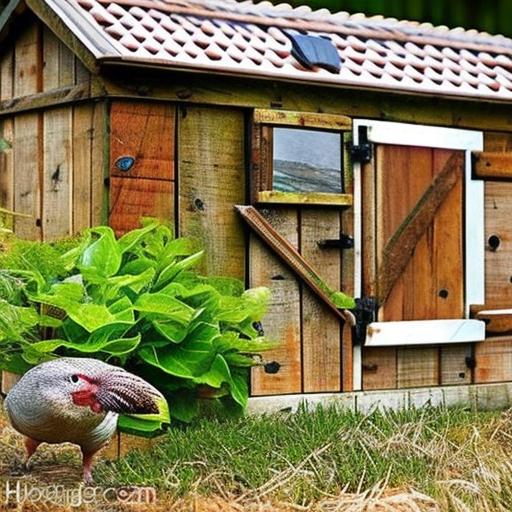Raising goats and chickens together can be a rewarding and beneficial experience for many reasons. Not only do these two animals complement each other in terms of their behaviors and needs, but they also provide a variety of products that can be harvested and utilized. Having a mixed flock can create a harmonious and sustainable environment on your farm or homestead.
One of the main benefits of having a mixed flock is the symbiotic relationship between goats and chickens. Goats are natural grazers and can help keep the pasture or grazing area well-maintained by eating weeds and grasses. Chickens, on the other hand, are excellent foragers and can help control pests such as insects and ticks. By combining these two animals, you can create a balanced ecosystem where each species contributes to the overall health of the land.
Another benefit of raising goats and chickens together is the joy it brings to the farmer or homesteader. Both goats and chickens have unique personalities and behaviors that can be entertaining to observe. From watching goats playfully jump around to seeing chickens scratch and peck at the ground, there is never a dull moment when you have a mixed flock. Additionally, interacting with these animals can be therapeutic and provide a sense of connection to nature.
Key Takeaways
- Raising goats and chickens together can provide numerous benefits, including pest control, fertilizer production, and a diverse source of food.
- Understanding the natural behaviors of goats and chickens is crucial for creating a harmonious mixed flock.
- Choosing the right breeds for a mixed flock involves considering factors such as temperament, size, and egg or milk production.
- Proper housing requirements for goats and chickens include providing separate sleeping areas and ensuring adequate space and ventilation.
- Meeting the feeding and nutrition needs of goats and chickens requires providing a balanced diet and access to fresh water and pasture.
- Managing health and disease in a mixed flock involves regular monitoring and preventative measures such as vaccinations and parasite control.
- Addressing behavioral issues in a mixed flock may involve providing separate feeding areas and addressing aggression or bullying.
- Balancing the needs of goats and chickens in a shared space requires careful planning and management to prevent overgrazing and ensure adequate resources.
- Harvesting and utilizing products from a mixed flock can provide a source of income and reduce waste.
- While raising goats and chickens together can be challenging, the rewards of a thriving mixed flock can be well worth the effort.
Understanding the Natural Behaviors of Goats and Chickens
To successfully raise goats and chickens together, it is important to understand their natural behaviors and how they interact with each other. Goats are social animals that thrive in herds. They have a strong hierarchy within their group and establish dominance through head-butting and other physical interactions. Chickens, on the other hand, have a pecking order within their flock, where the dominant birds assert their authority by pecking at lower-ranking individuals.
Despite these differences in behavior, goats and chickens can coexist peacefully if given enough space and resources. Goats are generally curious and may investigate the chickens, but they rarely show aggression towards them. Chickens, on the other hand, may be wary of the larger goats and will usually keep their distance. It is important to provide enough space for both species to roam freely and establish their own territories.
Choosing the Right Breeds for a Mixed Flock
When selecting breeds for a mixed flock, it is important to choose ones that are compatible with each other and have similar needs. Some goat breeds, such as Nigerian Dwarf and Pygmy goats, are smaller in size and can coexist more easily with chickens. These breeds are also known for their friendly and docile nature, making them less likely to cause harm to the chickens.
In terms of chicken breeds, it is best to choose ones that are not easily intimidated by larger animals. Breeds such as Rhode Island Reds, Sussex, and Orpingtons are known for their calm and confident demeanor, which can help them coexist with goats. Additionally, it is important to consider the size of the chicken coop or housing area to ensure that there is enough space for both goats and chickens.
Housing Requirements for Goats and Chickens
| Animal | Minimum Housing Requirements | Ideal Housing Requirements |
|---|---|---|
| Goats | 10 square feet per goat | 20-25 square feet per goat |
| Chickens | 2-3 square feet per chicken | 4-5 square feet per chicken |
Both goats and chickens have specific housing requirements that need to be met in order to keep them healthy and safe. Goats require a sturdy shelter that protects them from extreme weather conditions such as rain, wind, and heat. The shelter should also have proper ventilation to prevent the buildup of moisture and ammonia from their waste. Additionally, goats need access to a secure outdoor area where they can graze and exercise.
Chickens, on the other hand, require a coop that provides protection from predators such as foxes, raccoons, and birds of prey. The coop should have nesting boxes for laying eggs, perches for roosting at night, and adequate ventilation to prevent respiratory issues. Chickens also need access to a secure outdoor area where they can scratch and forage for insects and plants.
To create a shared space for goats and chickens, it is important to separate their housing areas within the larger enclosure. This can be done by using fencing or other barriers to keep the animals separate when necessary. It is also important to provide enough space for both species to move around comfortably and establish their own territories.
Feeding and Nutrition Needs of Goats and Chickens
Proper feeding and nutrition are essential for the health and well-being of both goats and chickens. Goats are ruminant animals, which means they have a complex digestive system that allows them to efficiently digest fibrous plant material. They require a diet that consists mainly of high-quality forage such as grass, hay, and browse. Additionally, goats need access to fresh water at all times and may require mineral supplements to meet their nutritional needs.
Chickens, on the other hand, are omnivorous animals that require a balanced diet of grains, protein, fruits, vegetables, and insects. They can be fed a commercial chicken feed that is specifically formulated for their nutritional needs. Additionally, chickens need access to fresh water at all times and may benefit from the addition of calcium supplements to support egg production.
To provide a balanced diet for both goats and chickens in a mixed flock, it is important to ensure that each species has access to their specific feed without interference from the other. This can be achieved by using separate feeding stations or by feeding them at different times of the day. It is also important to monitor their body condition and adjust their diet as needed to prevent obesity or malnutrition.
Managing Health and Disease in a Mixed Flock

Managing the health and disease of a mixed flock requires regular monitoring and preventive measures. Both goats and chickens are susceptible to certain diseases that can be transmitted between species. It is important to consult with a veterinarian to develop a vaccination and deworming schedule for both goats and chickens.
Common diseases that affect goats include parasites such as worms and coccidia, respiratory infections, and foot rot. Chickens are susceptible to diseases such as Marek’s disease, coccidiosis, and respiratory infections. It is important to practice good biosecurity measures, such as keeping the housing areas clean and disinfecting equipment, to prevent the spread of diseases.
Addressing Behavioral Issues in a Mixed Flock
Behavioral issues can arise in a mixed flock, especially if the animals are not properly managed or if their needs are not being met. One common behavioral issue is aggression between goats and chickens. Goats may become territorial and try to assert dominance over the chickens, which can result in injury or stress for both species.
To address this issue, it is important to provide enough space for both goats and chickens to establish their own territories. Additionally, providing separate feeding stations and ensuring that each species has access to their specific needs can help prevent conflicts. If aggression persists, it may be necessary to separate the animals or provide additional enrichment activities to redirect their behavior.
Balancing the Needs of Goats and Chickens in a Shared Space
Balancing the needs of goats and chickens in a shared space requires careful planning and management. It is important to provide enough space for both species to roam freely and establish their own territories. This can be achieved by dividing the larger enclosure into separate areas for goats and chickens using fencing or other barriers.
Additionally, it is important to provide adequate shelter, feeding stations, and water sources for both species. This can help prevent competition and ensure that each animal has access to their specific needs without interference from the other. Regular monitoring of the animals’ behavior and body condition can help identify any issues or imbalances in their environment.
Harvesting and Utilizing Products from a Mixed Flock
One of the benefits of having a mixed flock is the variety of products that can be harvested and utilized. Goats provide milk, which can be used to make cheese, yogurt, and other dairy products. Chickens provide eggs, which can be used for cooking or sold for profit. Additionally, both goats and chickens produce manure, which can be used as fertilizer for gardens and crops.
To harvest and utilize these products, it is important to have the necessary equipment and knowledge. Milking goats requires a milking stand and proper sanitation practices. Collecting eggs from chickens requires nesting boxes and regular egg collection to prevent spoilage. Proper composting techniques can be used to turn goat and chicken manure into nutrient-rich fertilizer.
The Joys and Challenges of Raising Goats and Chickens Together
Raising goats and chickens together can be a rewarding and fulfilling experience, but it also comes with its challenges. The joys of observing their natural behaviors, harvesting their products, and creating a sustainable environment are unparalleled. However, proper management and care are essential to ensure the health and well-being of both species.
By understanding the natural behaviors of goats and chickens, choosing the right breeds, providing appropriate housing and nutrition, managing health and disease, addressing behavioral issues, and balancing their needs in a shared space, you can create a successful mixed flock. With proper care and attention, raising goats and chickens together can be a fulfilling and sustainable endeavor for any farmer or homesteader.
If you’re considering keeping goats and chickens together, you may be interested in this article on the Poultry Wizard website: “How to Convert a Shed into a Chicken Coop.” This informative piece provides step-by-step instructions on transforming a shed into a suitable living space for your chickens. It covers important aspects such as ventilation, insulation, and predator-proofing. Whether you already have a shed or are planning to build one, this article will guide you through the process of creating a safe and comfortable coop for your feathered friends. Read more here.
FAQs
What are the benefits of keeping goats and chickens together?
Keeping goats and chickens together can provide several benefits, such as reducing the need for chemical fertilizers, improving soil quality, and increasing food production.
Can goats and chickens share the same living space?
While goats and chickens can share the same living space, it is not recommended. Goats require more space and have different dietary needs than chickens, which can lead to health problems if they are housed together.
What are the risks of keeping goats and chickens together?
The risks of keeping goats and chickens together include the spread of diseases, such as avian influenza and goat pox, and the potential for goats to injure or kill chickens.
What should be considered before keeping goats and chickens together?
Before keeping goats and chickens together, it is important to consider the space requirements, dietary needs, and potential risks. It is also important to ensure that the animals have separate living spaces and are properly supervised.
What are some tips for keeping goats and chickens together?
Some tips for keeping goats and chickens together include providing separate living spaces, ensuring that the animals have access to clean water and food, and monitoring their behavior for signs of aggression or illness. It is also important to consult with a veterinarian for advice on proper care and management.
Meet Walter, the feathered-friend fanatic of Florida! Nestled in the sunshine state, Walter struts through life with his feathered companions, clucking his way to happiness. With a coop that’s fancier than a five-star hotel, he’s the Don Juan of the chicken world. When he’s not teaching his hens to do the cha-cha, you’ll find him in a heated debate with his prized rooster, Sir Clucks-a-Lot. Walter’s poultry passion is no yolk; he’s the sunny-side-up guy you never knew you needed in your flock of friends!







